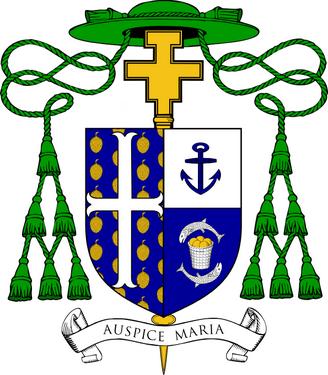Bishop Ruggieri's Coat of Arms
 Heraldic Achievement of
Heraldic Achievement of
MOST REVEREND JAMES T. RUGGIERI
Thirteenth Bishop of Portland
Azure semy of pine cones Or, a Cross moline throughout argent, impaling per fess argent and azure, in chief an anchor azure, and in base between two fish naiant in annulo a basket argent containing five round loaves Or.
In designing the shield—the central element in what is formally called the heraldic achievement—a Bishop has an opportunity to depict symbolically various aspects of his own life and heritage, and particular aspects of Catholic faith and devotion. The formal description of a coat of arms, known as the blazon, uses a technical language, derived from medieval French and English terms, which allows the appearance and position of each element in the achievement to be recorded precisely.
A diocesan bishop shows his commitment to the flock he shepherds by combining his personal coat of arms with that of the diocese, in a technique known as impaling. The shield is divided in half along the pale or central vertical line. The arms of the diocese appear on the dexter side —that is, on the side of the shield to the viewer’s left, which would cover the right side (in Latin, dextera) of the person carrying the shield. The arms of the bishop are on the sinister side — the bearer’s left, the viewer’s right.
The arms of the Diocese of Portland were adopted when the diocese was founded in 1853. The blue background is scattered with pine cones painted gold (azure, semy of pine cones Or), recalling Maine’s nickname, “The Pine Tree State.” The layout is based on the coat of arms of the royal house of France used in the thirteenth and fourteenth centuries, which had a similar blue background scattered with gold fleurs-de-lis (azure seme-de-lis Or).
The design was chosen to recall that the first settlers of what is now Maine were French colonists, who settled on what became known as Saint Croix Island. The island, and the river in which it is situated, are named after the Holy Cross (Saint-Croix in French), and the shield bears the prominent charge of a cross with forked ends, known as a Cross Moline. The personal arms of Bishop Ruggieri are divided horizontally (per fess). The upper half is painted white (argent) and bears an anchor painted blue (azure). It recalls the birthplace and home of the Bishop in the Diocese of Providence, Rhode Island. That state’s flag and seal comprise a gold anchor and a scroll with the motto “Hope.”
The anchor is an ancient symbol of the theological virtue of hope, deriving from the words of the Letter to the Hebrews: “We have this hope as a sure and steadfast anchor of the soul …” (Hebrews 6:19). In this depiction, the stock of the anchor is positioned on the shank to resemble a Passion Cross, an equally ancient symbol of the theological virtue of faith. As Pope Benedict XVI pointed out, “Hope, in fact, is a key word in Biblical faith—so much so that in several passages the words faith and hope seem interchangeable. Thus, the Letter to the Hebrews closely links the “fullness of faith” (10:22) to “the confession of our hope without wavering” (10:23).
In the lower half of the shield is a depiction of the five loaves and two fish that the Lord Jesus multiplied to feed five thousand men and their families. The only pre-resurrection miracle that is recounted in all four Gospels (Mt 14:13-21; Mk 6:32-44; Lk 9:10b-17; Jn 6:1-15), it holds a special place in the story of the public ministry of Jesus and points to the institution of the Eucharist at the Last Supper. The Feeding of the Five Thousand also highlights the cooperation of the apostles – whose successor the bishop is – with the Lord, both in the ministry of charity, and as celebrants and guardians of the Holy Eucharist and the other sacraments.
Externals
The shield itself is ensigned with external elements that identify the bearer as a bishop. A gold processional cross appears behind the shield. In this rendering of his arms, the bishop has chosen to depict the cross in the shape of the San Damiano Cross, before which Saint Francis of Assisi heard the call of God to “restore my Church.” The galero or “pilgrim’s hat” is used heraldically in various colors and with specific numbers of tassels to indicate the rank of a bearer of a coat of arms. A bishop uses a green galero with three rows of green tassels.
Scroll and Motto
Below the shield is a scroll bearing the motto “Auspice Maria,” which translates from Latin as “Under the protection of Mary.” It draws together the symbolism of the various parts of the bishop’s arms, as the words of Cardinal Robert Sarah explain:
The joyous veneration given to the Mother of God by the contemporary Church, in light of reflection on the mystery of Christ and on his nature, cannot ignore the figure of a woman (cf. Gal 4:4), the Virgin Mary, who is both the Mother of Christ and Mother of the Church. …[G]rowth in the Christian life must be anchored to the Mystery of the Cross, to the oblation of Christ in the Eucharistic Banquet and to the Mother of the Redeemer and Mother of the Redeemed, the Virgin who makes her offering to God.*
* Dicastery for Divine Worship and the Discipline of the Sacraments. Decree on the celebration of the Blessed Virgin
Mary, Mother of the Church, in the General Roman Calendar, 2018.
Bishop Ruggieri’s coat of arms was designed by Father Philip G. Bochanski, vicar general and moderator of the curia for the Archdiocese of Philadelphia.









